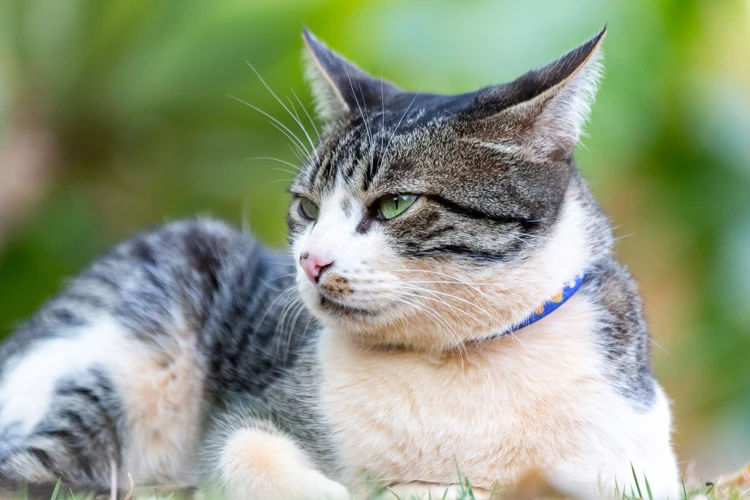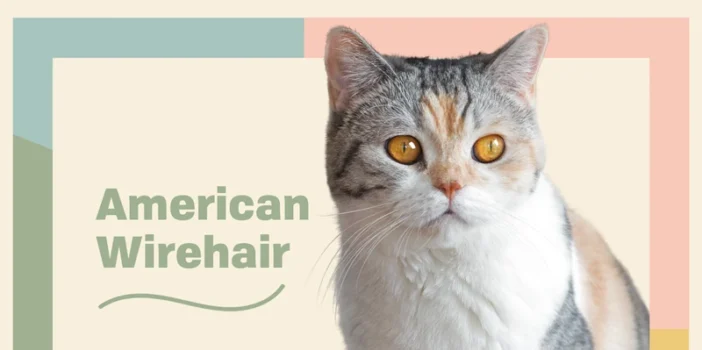As cat owners, we all want our furry friends to thrive and enjoy their lives with us. However, some American Wirehair cats may experience shyness or anxiety, which can make socialization a challenge. It can be frustrating to see your beloved pet struggle to interact with others. But fear not! In this article, we will share effective socialization techniques that can help your shy or anxious American Wirehair cat feel more comfortable in their surroundings. From creating a safe space to introducing them to new environments, we’ll cover it all. So, let’s dive in and explore how we can make our feline friends feel more at ease!
Understanding Your Shy or Anxious American Wirehair Cat

Understanding Your Shy or Anxious American Wirehair Cat: As a pet owner, it’s essential to know the personality and behavior of your American Wirehair cat. Each cat has different personality traits, and some may be shy or anxious in new environments or around new people. In this section, we’ll explore how to identify the signs of shyness and anxiety in American Wirehairs, the causes behind such behavior, and how to socialize them. Understanding your cat’s behavior and needs will help you build a stronger bond with your furry friend and ensure a happy and comfortable life. If you are seeking more information related to American Wirehair kitten socialization, click here to read our previous article.
Identifying Shyness and Anxiety in American Wirehairs
Identifying shyness and anxiety in American Wirehairs may seem difficult because of their generally calm temperament. However, there are some subtle signs that you can look for in your furry pet. If you notice any of the following behaviors, know that your American Wirehair may be feeling shy or anxious.
1. Hiding: One of the most obvious signs of shyness or anxiety in American Wirehairs is hiding. If you find your pet hiding under the bed or in the closet when encountering strangers or a new environment, it is a sure-shot sign that they are feeling shy or anxious.
2. Avoidance: Avoidance is another classic symptom of shyness or anxiety. If your American Wirehair tries to steer clear of social situations, such as avoiding people, other pets, or activities, it may indicate that they are feeling anxious or fearful.
3. Excessive Grooming: American Wirehairs are famous for their excellent grooming habits, but excessive licking or grooming, particularly in stressful situations, can be a sign of anxiety or nervousness.
4. Aggression: Aggressive behavior, such as hissing, scratching or biting, may indicate that your American Wirehair feels threatened or anxious. In some cases, aggression might be due to other unrelated reasons such as sickness or irritation, so it is essential to be observant of your cat’s behavior.
Knowing the signs of shyness or anxiety in American Wirehairs is the first step in helping your cat feel more comfortable and secure. If you observe any of these behaviors, try to provide a calm and safe environment and be patient with them. Remember, every cat is unique, and some may take longer to socialize than others. However, with a little effort and time, your American Wirehair can eventually become more confident and sociable.
Causes of Shyness and Anxiety in American Wirehairs
Shyness and anxiety are common traits among American Wirehair cats. Understanding the underlying causes is essential for developing effective socialization techniques.
There are numerous reasons why American Wirehairs may exhibit shy or anxious behavior. Some of the most common causes include genetics, lack of socialization as kittens, traumatic experiences, or living in a stressful environment.
Genetics plays a significant role in a cat’s behavior. Some American Wirehairs may simply be predisposed to shyness and anxiety due to their genetic makeup. However, proper socialization techniques can help alleviate these tendencies.
Lack of socialization during kittenhood is also a common cause of shyness and anxiety in American Wirehairs. Kittens who are not socialized properly may not be comfortable around people, other cats, or new environments. This can lead to anxiety and fear in adult cats.
Traumatic experiences such as abuse, abandonment, or neglect can also cause shyness and anxiety in American Wirehairs. These experiences can have a lasting impact on a cat’s behavior and require a patient approach when it comes to socialization.
Living in a stressful environment can also lead to anxious behavior in American Wirehairs. Cats that are exposed to loud noises, frequent visitors, or other stressful situations may develop anxiety or shyness as a way of coping with their environment.
The causes of shyness and anxiety in American Wirehairs can be complex and varied. However, with patience, consistency, and the right socialization techniques, it is possible to help your furry friend overcome these behaviors and become a happy, well-adjusted member of your household.
Learn more about socializing American Wirehair kittens.
Socialization Techniques for American Wirehair Cats

Encouraging socialization for American Wirehair cats is an important step in their development and overall well-being. Proper socialization allows your feline friend to feel confident and comfortable in different situations, reducing the risk of fearful or aggressive behavior later in life. However, socializing a shy or anxious American Wirehair can be a challenge. By following these effective techniques below, you can help your cat feel safe to explore their surroundings and interact with others in a positive way. Keep reading to learn more about socialization techniques that are tailored specifically to American Wirehair cats.
Start with a Safe and Comfortable Space
When it comes to socializing a shy or anxious American Wirehair cat, it’s important to start by creating a safe and comfortable space for them. This area should be a place where the cat feels secure and is able to retreat to if they become overwhelmed or frightened. It can be a cozy bed in a quiet room, a covered cat carrier, or a small space with comfortable bedding.
Table: Tips for Creating a Safe and Comfortable Space
| Tips | Explanation |
|---|---|
| Choose a quiet location | Find a room or area away from loud noises and household traffic to help your cat feel at ease. |
| Provide a cozy bed or carrier | Give your cat a soft, comfortable place to rest where they feel secure. |
| Use pheromone sprays or diffusers | Products like Feliway can help create a calming environment for your cat. |
| Offer food, water, and litter box access | Make sure your cat has everything they need in their safe space, so they don’t feel the need to venture out and become overwhelmed. |
It’s important to remember that every cat is different and may have varying preferences when it comes to their safe space. Some cats may prefer a covered carrier, while others may prefer an open bed. Pay attention to your cat’s body language and behavior to gauge what makes them feel safe and secure.
Creating a safe space is just the first step in socializing a shy or anxious American Wirehair cat. Be sure to visit the other sections of this article for more helpful tips and techniques for socializing your furry friend. And if you’re interested in socializing a Wirehair kitten or training your American Wirehair to avoid aggressive behavior, be sure to check out our other articles on the topic.
Use Positive Reinforcement to Build Trust
One of the most effective techniques for socializing shy or anxious American Wirehair cats is to use positive reinforcement. Positive reinforcement involves rewarding desirable behavior to encourage it to happen more frequently. With consistent positive reinforcement, your American Wirehair cat can learn to associate new experiences with positive outcomes, making them more willing to participate in them.
To use positive reinforcement, start by identifying your American Wirehair’s favorite treats or toys. When you introduce them to new experiences or situations, reward them with their favorite treats or toys when they respond positively. For example, if your American Wirehair is afraid of new people, gradually introduce them to a new person and give them treats or playtime immediately after the introduction. Repeat this process until your American Wirehair feels comfortable with the person’s presence.
It’s important to note that positive reinforcement should be used consistently and immediately after desired behavior. If your American Wirehair does something you don’t want them to do, such as scratching the furniture, redirect their attention to a toy or scratching post and reward them when they use it instead. This will help them associate positive outcomes with the desired behavior and break the habit of unwanted behavior.
Positive reinforcement can be used in combination with all of the other socialization techniques mentioned in this article to further increase their effectiveness. For more detailed information on socializing American Wirehair kittens with other pets, click here. If you’re wondering how to socialize your American Wirehair kitten with children, read our guide here. And if your American Wirehair cat is exhibiting aggressive behavior, check out our article on training techniques for aggressive behavior.
Introduce Your American Wirehair to New People and Animals Gradually
Introducing your American Wirehair cat to new people and animals can be a daunting task, especially if your cat is shy or anxious. The key is to take it slow and introduce new stimuli gradually. Below are some tips to help you introduce your cat to new people and animals in a safe and comfortable way:
| Tip | Description |
|---|---|
| 1. Start with Familiar People | Start by introducing your cat to people that they already know and feel comfortable around. This will help build their confidence and make them more open to meeting new people in the future. |
| 2. Keep It Short and Sweet | When introducing your cat to new people or animals, keep the interactions short. This will prevent overwhelming your cat and allow them to gradually adjust to new stimuli. |
| 3. Use Treats and Toys | Use treats and toys to help distract your cat and make them feel more comfortable around new people and animals. This will help build positive associations with new stimuli. |
| 4. Use Positive Reinforcement | Use positive reinforcement to reward your cat for good behavior around new people and animals. This will help them associate positive experiences with new stimuli. |
| 5. Gradually Increase Exposure | Gradually increase the amount of exposure your cat has to new people and animals over time. This will help them build confidence and feel more comfortable around new stimuli. |
Remember to be patient and take it slow when introducing your American Wirehair cat to new people and animals. With time, patience, and positive reinforcement, your cat will become more confident and comfortable in social situations.
Encourage Playtime and Exercise
Keeping your American Wirehair cat mentally and physically stimulated is crucial for their overall well-being and plays a significant role in reducing shyness and anxiety. One of the best ways to achieve this is by encouraging playtime and exercise. Here are a few ways to get your American Wirehair cat moving:
- Invest in toys: Provide your cat with a variety of toys, such as feather wands, laser pointers, and interactive toys. This will keep them entertained and engaged.
- Create a play area: Set up an area in your home where your cat can run around and play. For example, you can create an obstacle course with boxes and tunnels, hide treats around the room or create a DIY scratching post from tree branches.
- Play with your cat: Dedicate time each day to play with your cat one-on-one. Use toys that encourage pouncing and chasing to help them release pent-up energy. Additionally, playing with your cat will strengthen your bond with them.
- Use puzzle feeders: Puzzle feeders require your cat to work for their food, which keeps them mentally stimulated and helps them improve their problem-solving skills. Use puzzle feeders to distribute their daily food intake.
- Take your cat for walks: Contrary to popular belief, some cats enjoy walking on a leash. If your cat is comfortable with a harness and leash, take them for short walks around your neighborhood or a nearby park.
Remember, every cat is unique, and not all types of play are suitable for every cat. Try different techniques and observe what works best for your American Wirehair cat to encourage playtime and exercise.
Invest in Interactive Toys and Puzzles
Interactive toys and puzzles are a great way to engage and socialize shy or anxious American Wirehair cats. Not only do they provide mental and physical stimulation, but they also help to build confidence and trust in your feline companion. Here are some types of interactive toys and puzzles to consider:
- Food Dispensing Toys: These toys dispense treats or kibble when your cat interacts with them. They encourage your cat to play and work for their food.
- Puzzle Feeders: Similar to food dispensing toys, puzzle feeders require your cat to solve a puzzle in order to access their food. This stimulates their problem-solving skills and encourages them to think and play.
- Catnip Toys: Catnip toys can be a great way to entice your cat to play and interact. The scent of catnip is stimulating and can help to reduce anxiety or stress in some cats.
- Interactive Wand Toys: These toys incorporate a long wand or string that you control, with an enticing toy on the end for your cat to chase and play with. This encourages your cat to get up and move around, while also building trust and bonding with you.
Remember to supervise your cat while they play with these toys, and to switch them out on occasion to keep things interesting. With patience and consistent playtime, your shy or anxious American Wirehair cat can become a confident and socialized feline companion.
Additional Tips and Tricks for Socializing American Wirehair Cats
Now that you have a good grasp of the causes of shyness and anxiety in American Wirehairs, as well as various techniques to socialize them, let’s take a look at some additional tips and tricks that can help you successfully socialize your furry companion. These tips will provide you with extra support and guidance, allowing you to build a strong bond with your cat and help them overcome their shyness and anxiety. Keep in mind that every cat is different, so be patient and flexible when using these techniques.
Practice Patience and Consistency
When it comes to socializing a shy or anxious American Wirehair cat, patience and consistency are key. It’s important to understand that this process may take time and effort, but with perseverance, your cat can become more confident and comfortable in social situations. Here are some tips for practicing patience and consistency in socializing your American Wirehair:
| Tip | Description |
|---|---|
| 1 | Stay Calm and Positive: Remember to stay calm and positive throughout the socialization process. Your cat will be able to sense your emotions, so remaining calm and patient will help them feel more secure and relaxed. |
| 2 | Stick to a Schedule: Consistency is key in helping your American Wirehair feel secure and comfortable in social situations. Try to establish a regular routine for socializing, such as a specific time of day or week, and stick to it as much as possible. |
| 3 | Gradual Exposure: When introducing your cat to new people or animals, it’s important to start with gradual exposure. This could involve simply allowing your cat to observe from a distance at first, and then gradually bringing them closer as they become more comfortable. |
| 4 | Use Reinforcement: Positive reinforcement can be a powerful tool in socializing your American Wirehair. Praise and reward your cat when they exhibit confident and sociable behavior, and avoid punishing them for hesitancy. |
| 5 | Monitor Progress: Keep track of your cat’s progress over time, and celebrate even small improvements. It’s possible that progress may be slow or inconsistent at times, but by monitoring and acknowledging it, you can help build your cat’s confidence over the long-term. |
By practicing patience and consistency, and following the other socialization techniques outlined in this article, you can help your shy or anxious American Wirehair become more confident and comfortable in social situations. Remember to remain calm, stick to a schedule, use gradual exposure, reinforce positive behavior, and monitor progress along the way. With time and effort, your American Wirehair can become a happy and sociable member of your family.
Consider Professional Help
If your American Wirehair cat is extremely shy or anxious, you may need to consider seeking professional help. A veterinary behaviorist or a certified cat behavior consultant can assess your cat’s behavior and provide guidance on how to improve their socialization skills.
Benefits of Professional Help
Professional help can be beneficial for both the cat and the owner. A behaviorist or consultant can develop a personalized plan for your cat’s specific needs, taking into account their unique personality and behavior. They can also provide support and guidance for the owner, helping them to understand their cat’s behavior and how to effectively train and socialize them.
Choosing a Professional
When choosing a professional to work with your American Wirehair, it’s important to do your research. Look for someone who is certified and has experience working with cats. A good behaviorist or consultant will have a thorough understanding of feline behavior and will use science-based techniques.
Costs of Professional Help
Professional help can be expensive, but it’s important to remember that the cost of not addressing your cat’s behavior issues can be higher in the long run. The cost can vary depending on the location, credentials, and experience of the professional. Be sure to ask about pricing and what the cost includes before making a commitment.
Conclusion
If your American Wirehair cat is exhibiting extreme shyness or anxiety, seeking professional help may be a necessary step. It’s important to choose a certified behaviorist or consultant who understands feline behavior and uses science-based techniques. While the cost can be high, it’s important to consider the long-term benefits for both you and your furry friend.
Conclusion
After learning about socialization techniques for shy or anxious American Wirehair cats, you should have a good understanding of how to help your feline friend build confidence and trust in their environment. Remember to always approach socialization with patience and consistency, as it may take time for your cat to adjust to new situations.
Establishing a safe and comfortable space for your cat is crucial in the socialization process. By using positive reinforcement and gradually introducing them to new people and animals, you can help your American Wirehair feel more at ease in their surroundings.
Additionally, playtime and exercise can help relieve stress and anxiety in your cat. Investing in interactive toys and puzzles can also provide mental stimulation and encourage positive behavior.
If you’re still having difficulty socializing your cat, consider seeking professional help from a veterinarian or animal behaviorist. With their expertise, they can offer personalized advice and support for your cat’s unique needs.
Overall, socializing a shy or anxious American Wirehair cat can be a challenging but rewarding experience. With patience, consistency, and the right approach, you can help your cat feel more comfortable and confident in their environment. Remember to always prioritize your cat’s well-being and make the process enjoyable for both you and your feline friend.
Frequently Asked Questions
1) How can I tell if my American Wirehair cat is shy or anxious?
Shy cats tend to avoid social interaction and may hide when they feel uncomfortable. Anxious cats may exhibit behaviors like excessive meowing, pacing, or aggression toward people or other animals.
2) Can American Wirehair cats learn to socialize even if they are naturally shy or anxious?
Yes, with patience and the right techniques, American Wirehairs can learn to become more comfortable with social interaction.
3) Are there certain breeds of cats that are more prone to shyness or anxiety?
Some breeds, like the American Wirehair, may be more prone to shyness or anxiety due to their personalities or past experiences.
4) Is it important to socialize my American Wirehair cat?
Yes, socializing your cat can reduce stress and anxiety, improve their overall behavior and health, and strengthen your bond with them.
5) What are some signs that my American Wirehair cat is becoming more comfortable with social interaction?
Increased confidence and curiosity, seeking out affection or play, and less avoidance or hiding can be signs that your cat is becoming more comfortable with socializing.
6) Can playing with my American Wirehair cat help with socializing?
Yes, playing can help build trust and reduce anxiety in your cat, making them more comfortable with social interaction.
7) Are there any toys or puzzles that are particularly helpful for socializing American Wirehair cats?
Interactive toys and puzzles that require your cat to use their brain and problem-solve can be great for building confidence and reducing anxiety. Examples include treat-dispensing toys or puzzle feeders.
8) Can I socialize my American Wirehair cat myself or should I seek professional help?
It’s possible to socialize your cat yourself, but if your cat’s shyness or anxiety is severe, seeking professional help from a veterinarian or animal behaviorist may be beneficial.
9) Is it important to start socializing my American Wirehair cat when they are young?
Starting socialization early can be beneficial, but it’s never too late to start.
10) Can socialization help my American Wirehair cat overcome fear of loud noises or other triggers?
Yes, with the right techniques and patience, socialization can help your cat become more comfortable with loud noises and other triggers that may cause anxiety.







